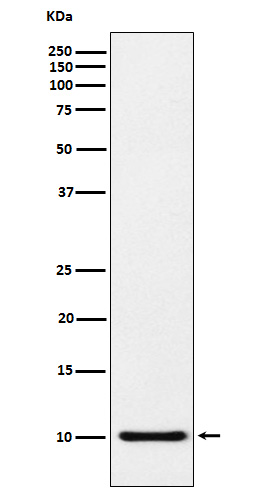
| WB | 咨询技术 | Human,Mouse,Rat |
| IF | 咨询技术 | Human,Mouse,Rat |
| IHC | 咨询技术 | Human,Mouse,Rat |
| ICC | 1/50-1/200 | Human,Mouse,Rat |
| FCM | 咨询技术 | Human,Mouse,Rat |
| Elisa | 咨询技术 | Human,Mouse,Rat |
| Aliases | SISd; eoCP; SCYA5; RANTES; TCP228; D17S136E; SIS-delta;;CCL5 |
| WB Predicted band size | 10 kDa |
| Host/Isotype | Rabbit IgG |
| Antibody Type | Primary antibody |
| Storage | Store at 4°C short term. Aliquot and store at -20°C long term. Avoid freeze/thaw cycles. |
| Species Reactivity | Human |
| Immunogen | A synthesized peptide derived from human CCL5 |
| Formulation | Purified antibody in PBS with 0.05% sodium azide,0.05% BSA and 50% glycerol. |
+ +
以下是关于RANTES(CCL5)抗体的3篇参考文献及其摘要概括:
1. **文献名称**:*RANTES-mediated chemokine activity in HIV-1 infection*
**作者**:Appay, V., et al. (2000)
**摘要**:该研究探讨了RANTES通过结合CCR5受体抑制HIV-1感染的机制,利用抗RANTES抗体证实了其在阻断病毒进入CD4+ T细胞中的作用,为抗病毒治疗提供理论依据。
2. **文献名称**:*RANTES expression in synovial fluid and tissue of rheumatoid arthritis patients*
**作者**:Carr, M.W., et al. (1994)
**摘要**:通过免疫组化及抗体中和实验,发现类风湿关节炎患者的滑膜组织和体液中RANTES表达显著升高,抗RANTES抗体可抑制炎症细胞趋化,提示其作为治疗靶点的潜力。
3. **文献名称**:*CCL5/RANTES in tumor microenvironment promotes macrophage infiltration*
**作者**:Menten, P., et al. (2002)
**摘要**:研究利用抗RANTES抗体阻断肿瘤分泌的CCL5.发现可显著减少肿瘤相关巨噬细胞(TAMs)的募集,抑制肿瘤血管生成和生长,揭示了RANTES在肿瘤免疫逃逸中的作用。
4. **文献名称**:*Role of CCL5 in neuroinflammation and multiple sclerosis*
**作者**:Sørensen, T.L., et al. (1999)
**摘要**:通过动物模型证明中枢神经系统中RANTES的异常表达与多发性硬化症(MS)相关,抗RANTES抗体可减轻炎症细胞浸润和脱髓鞘病变,支持其作为神经炎症调控因子的功能。
RANTES (Regulated on Activation, Normal T Cell Expressed and Secreted), also known as CCL5. is a chemokine belonging to the CC subfamily. It is produced by various cell types, including T cells, macrophages, endothelial cells, and fibroblasts, and plays a critical role in immune responses by recruiting leukocytes such as T cells, monocytes, and eosinophils to sites of inflammation. RANTES binds to multiple receptors, including CCR1. CCR3. and CCR5. and is implicated in chronic inflammatory diseases, viral infections (e.g., HIV), cancer progression, and autoimmune disorders.
Antibodies targeting RANTES are essential tools for studying its expression, localization, and function in both physiological and pathological contexts. These antibodies, available as monoclonal or polyclonal forms, are widely used in techniques like ELISA, Western blotting, immunohistochemistry, and flow cytometry. They enable researchers to quantify RANTES levels in biological samples, visualize its distribution in tissues, and investigate its role in disease mechanisms. For example, RANTES antibodies help elucidate its dual role in HIV pathogenesis—acting both as a chemoattractant and as a competitor for viral entry via CCR5 receptor blockade. In cancer research, such antibodies aid in exploring RANTES' contribution to tumor microenvironment modulation, angiogenesis, and metastasis.
When selecting RANTES antibodies, specificity validation (e.g., using knockout controls) and cross-reactivity checks across species are critical. Some antibodies target distinct epitopes or post-translational variants, influencing experimental outcomes. Therapeutic applications, such as blocking RANTES-receptor interactions in inflammatory diseases, further highlight the antibody's translational relevance.
×